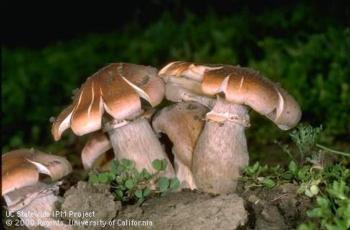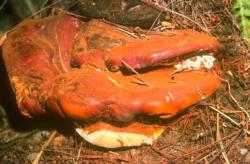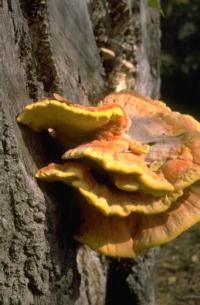Unused stories
Pest of the Month - Wood rot

I love trees. There’s nothing quite like the beauty and majesty of a venerable “Grand Dame” in the garden or dotting Marin’s hillsides. In addition to their visual delight, trees provide many benefits – shade in the summer or a break for cold winter winds, structure, privacy and habitat for a wide variety of wildlife. They can enhance the value of a property, create a place for children of all ages to play, and even serve as barometers of the passage of time and fond memories. If you’ve got mature trees in your garden, you want to do all you can to protect these valuable treasures. Even when given an optimum cultural environment and having the appearance of good health, your prized tree may be plagued with a disease that can result in a limb crashing down or an entire tree toppling when you least expect it.


Serious wood rots are caused primarily by fungi that grow inside wood cells, producing enzymes that break down cell wall components. The two main groups of decay fungi are white and brown rots. Wood infected by white rot feels moist, soft, spongy, or stringy and appears white or yellow. Strength losses are not significant until late stages of decay. Brown rot, also known as dry rot, is generally more serious than white rot. It affects mostly conifers; the rotted wood appears dry and fragile and readily crumbles into cubes. Since large losses of wood strength can result from brown rot, living trees with this decay can be hazardous and may fail.
The only outward sign of infection in an otherwise healthy looking tree may be the tell-tale fungal fruiting bodies, mushrooms, conks or brackets, located around wounds on the bark, at branch scars or the root crown. Oak root fungus, Armillaria mellea, produces mushrooms at the base of affected trees after fall and winter rains. This white rot is one of the most widespread plant diseases in California and affects most coniferous and broadleaved woody species. Varnish fungus rot, another white rot, displays red-brown annual conks that can grow up to fourteen inches wide and are coated on top with a distinctive, varnish-like surface. This rot infects many ornamental (acacia, ash, birch, boxwood, sweet gum, black and honey locust, magnolia, maple, oak, pepper tree, pine, poplar, redbud, spruce, and willow) and fruit trees (apple, cherry, citrus, olive and peach). The sulfur fungus causes a brown heart rot of living trees but will also decay dead trees, producing soft, fleshy, moist conks that are bright orange-yellow above and red-yellow below that grow up to twelve inches wide; it also can infect a wide range of trees.
Wood rots are difficult to manage once established. Prevent infection by keeping trees healthy and vigorous through excellent cultural care and protecting them from injury. Cut out dead or diseased limbs from infected trees. Hazardous trees may need to be trimmed, cabled, braced, or removed. Have a qualified expert assess the tree and recommend appropriate treatment.
By Nanette Londeree
Photos courtesy of UC IPM website; from top, mushrooms of oak root fungus, varnish fungus and sulfur fungus conks
